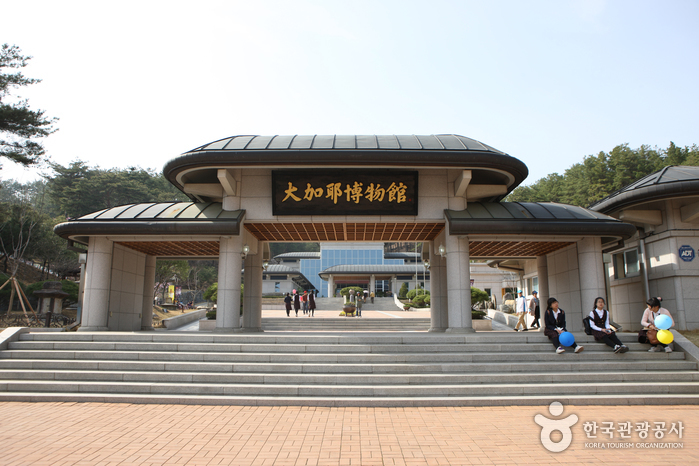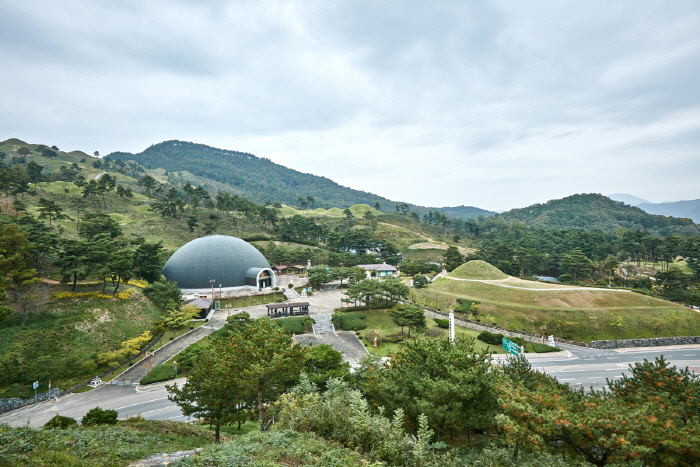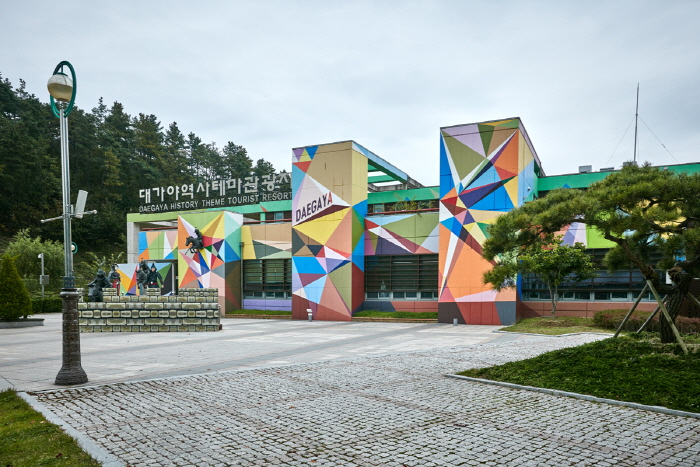Museo de Daegaya (대가야 박물관)
.0M 2022-09-13
Daegaya-ro 1203, Daegaya-eup, Goryeong-gun, Gyeongsangbuk-do.
Es un centro de exposición integral, en donde los visitantes podrán conocer la historia y la cultura completa de la época de Daegaya, participando en los diferentes tipos de programas. También podrán experimentar sus costumbres y tradiciones folclóricas. Exhibe y conserva aproximadamente 300 reliquias excavadas en el área histórica de Jisan-dong, del distrito de Gobun-gun, declarado Sitio Histórico, y los encontrados en la zona de Goryeong.
Los patrimonios descubiertos se representan con los mismos formatos que en la antigüedad, y en particular el pabellón con el techo con forma de bóveda, en dimensión y estructura, es el mejor del país. El museo también cuenta con instalaciones anexas de última tecnología, materiales audiovisuales, sector de búsqueda de información, túnel de imágenes, etc. Recorriendo el museo, podrá apreciar la espléndida cultura del hierro y el barro correspondiente a aquella época y descubrirá que esto ha influenciado a algunas épocas antiguas de Japón.
Sitio Histórico de Daegaya en Goryeong (고령 대가야유적지)
84.6M 2021-05-14
Daegaya-ro 1203, Daegaya-eup, Goryeong-gun, Gyeongsangbuk-do.
Goryeong es una ciudad que queda a 4 horas de Seúl y por toda la zona de Goryeong-gun hay muchas reliquias del antiguo reino de Daegaya. Daegaya se formó en el área inferior del río Nakdonggang, al sur de la península coreana, que alrededor de siglo I y prosperó independientemente durante 520 años (42 d.C-953 d.C), para decaer a partir del siglo VI. Después de su decadencia, una parte de su territorio fue dominado por Silla (57 a.C-935 d.C) y el resto fue dominado por Baekje (18 a.C-60 d.C), y pasó a ser un reino tribal en el olvido.
En el 23er. año del reinado de Jinheung (540-576), esta área pasó a llamarse distrito de Daegaya y durante el 16to. año del reinado de Gyoengdeok (712-765), tomó el nuevo nombre de Goryeong. Aquí se puede ver el primer sunjangmyo del pais (una tumba donde se enterraban a muchas personas juntas), llamado Tumbas Reales de Jisan-dong. También está el pabellón de exposiciones de las tumbas reales de Daegaya, así como el Tesoro N° 605 que es el sitio de las reliquias preeminentes del período prehistórico llamado Yangjeondong Amgakhwa, y muchos otros patrimonios culturales.
En las áreas más montañosas, hay una gran tumba antigua de un diámetro de 20 metros, y descendiendo por la ladera de una colina, hay otras 159 tumbas de menor escala. La tumba más grande del lado sureño se llama Tumba Real Geumrim, y las otras tumbas cercanas son las tumbas de aristócratas o de la familia real.
En el pabellón de exposiciones de la tumba de la realeza de Daegaya, el sitio de la tumba N°44 fue restaurado y podrá ver la antigua costumbre de entierro de los muertos junto con los vivos (a la realeza se la enterraba junto con sus sirvientes). El edificio con forma de cúpula expone artículos de hierro y cerámica y muchas otras reliquias excavadas.
Festival de Daegaya en Goryeong (고령대가야축제)
308.6M 2025-03-27
Daegaya-ro 1216, Goryeong-gun, Gyeongsangbuk-do
054-950-6427
* La edición 2025 del festival se ha cancelado debido a incendios forestales en la región.
Complejo Temático de la Historia de Daegaya (대가야 역사테마관광지)
364.6M 2021-12-10
Daegaya-ro 1216, Daegaya-eup, Goryeong-gun, Gyeongsangbuk-do
+82-54-950-7005
Este es un parque temático que enseña sobre la cultura y la historia de la cultura del antiguo reino de Daegaya, utilizando tecnología de punta. Además, hay espacios verdes que ofrecen un rico descanso a los visitantes.
Túmulos de Jisan-dong en Goryeong (고령 지산동 고분군)
366.6M 2022-09-19
Daegaya-eup, Goryeong-gun, Gyeongsangbuk-do.
Goryeong, capital del reino de Daegaya que tomó el poder tras la caída de Geumgwangaya, entre los 6 reinos de Gaya, prácticamente es un museo al aire libre. Sobre la cresta del sudeste del monte Jusan se hallan 200 túmulos de Daegaya. Sobre esta cresta se encuentra el túmulo que mide 20 m de diámetro, otros medianos están en el centro de Daegaya-eup y los pequeños al pie de la montaña. El túmulo más grande del sur se llama Geumnimwangneung.
Desde 1977, se realizó activamente la excavación tras el descubrimiento de los túmulos por la Universidad Gyeongbuk y Universidad Gyemyeong, lo cual ayudó en gran medida las investigaciones sobre Daegaya. Encontraron grandes cantidades de coronas de oro, accesorios de oro, plata y jade, armaduras, etc. Sobre todo, en el túmulo nº 42 se hallaron 32 salas secundarias alrededor de la sala principal para el entierro de vivos con el muerto, lo cual hizo comprobar el sistema de este tipo de entierro. Hay un museo que se llama el Museo de Túmulos Reales de Daegaya, construido para dar a conocer características de tumbas con el entierro de vivos con el muerto y la estructura social de ese período.
Hwanggeumteo Sutbul Garden (황금터숯불촌)
2.0Km 2009-11-12
Kwaebin-1(il)ri 351-7, Goryeong-eup, Goryeong-gun, Gyeongsanbuk-do.
At an accessible location in Goryeong, an old capital city of the Gaya Kingdom,
Hwanggeumteo Sutbul Garden with its spacey parking lot is the best spot to stop by and relax after touring the ruins of the Gaya Kingdom.
You can savor some quality meat provided at Hwanggeumteo Sutbul Garden where the wooden architecture with big and tall windows will create an awesome atmosphere to dine.
It is a cozy family operated restaurant where you must stop by.
Chuwoojae House [Korea Quality] / 추우재 [한국관광 품질인증]
6.5Km 2021-04-05
20-1, Gaesil 2-gil, Ssangnim-myeon, Goryeong-gun, Gyeongsangbuk-do
+82-54-956-4022 / +82-10-3207-4022
The village of Gaesil is known as the village of the Seonsan Kim clan. It was established by the descendants of Kim Jong-jik (pen-name: Jeompiljae, 1431-1492), a leading Korean Neo-Confucian scholar and the founder of the Yeongnam Sarim faction during the mid-Joseon period. Boasting over 300 years of tradition, the village is home to sixty households as well as a number of cultural heritages including the head house of Kim Jong-jik (Provincial Folk Material No. 62), Doyeonjae (Provincial Cultural Heritage material No. 111), which is the old village school, and the printing woodblocks for a collection of literary works including Yijonrok (a book about the life and achievements of Kim’s father Kim Suk-ja) written by Kim Jong-jik (Provincial Tangible Cultural Heritage No. 175).
The residents have renovated the village’s earthen walls and hanok houses into a current hanok village, and also run various hands-on experience programs including a hanok stay, a farm product cultivation program, and traditional etiquette and games, thereby offering urban travelers an opportunity to experience a truly rural lifestyle. Chuwoojae House, situated in the heart of the village of Gaesil, has two buildings that are available for rent including the bonchae, which is a single-family house, and the sarangchae, which is a detached building). All guestrooms are equipped with a bathroom and cooking facilities. In particular, the bonchae is heated with a furnace. Guests can use the village public parking lot, but there is also a separate parking lot not far from the house.
Yeonpung Gotaek (the Old House of Munchung) [Korea Quality] / 연풍고택/문충고가 [한국관광 품질인증]
6.6Km 2020-09-09
44, Gaesil 1-gil, Ssangnim-myeon, Goryeong-gun, Gyeongsangbuk-do
+82-54-956-4022 / +82-10-3207-4022
Located in the village of Gaesil in Hapga-ri, Ssangnim-myeon, Goryeong-gun, Gyeongsangbuk-do, the Old House of Yeonpung is an historic 150-year-old house, and was formerly the anchae (the inner house) among the four structures built by the current owners’ ancestor, who served as the governor of Yeonpung-hyeon, Goesan-gun, Chungcheongbuk-do. The house was restored after being bombed during the Korean War, and is currently is used to accommodate visitors or for village events.
The Old House of Yeonpung is situated behind Hwasanjae Pass, which is the traditional wedding experience site of Gaesil village. It is considered a propitious site according to geomantic theory as there is a bamboo forest to its rear. During restoration work in 2010, the large anchae, which covered about 2,644m2, was renovated into a modern structure with four rooms.
In particular, the Juksil and Maesil rooms are very large, making them ideal for families and groups. A separate building with a large courtyard and a BBQ facility is available for guests who want to cook or have a barbecue. The charming courtyard comprises a well, a bench, and various flower trees.
Known as the village of the Seonsan Kim clan, Gaesil Village was founded by the descendants of Kim Jong-jik (pen-name: Jeompiljae, 1431-1492), a leading Korean Neo-Confucian scholar of the early Joseon period who died during the Literati Purge of 1498. The head house of Kim Jong-jik (Provincial Folk Material No. 62) and Doyeonjae (Provincial Cultural Heritage Material No. 111), the old village school, are also situated in the village. In addition, the nearby Daegaya Museum displays the writing accessories of Kim Jong-jik (Provincial Tangible Cultural Heritage No. 209).
The village is also known as Gaehwasil, meaning “a beautiful valley with blooming flowers” as it is surrounded by a flower-covered mountain called Mt. Hwagaesan, a 350-year-old bamboo forest, and Jeopmubong Peak, which is said to resemble a fluttering butterfly. Over 80% of the village houses are traditional hanok buildings nestled amid a cozy environment.
During the Campaign to Create Beautiful Communities conducted in 2001 and the Farm Experience Village Development Project in 2005, the village’s hanok were renovated or entirely rebuilt, earthen-stone walls were built, walking paths created, and refined landscaping works carried out, establishing the village in its current form. Furthermore, a village shelter, experience center, Internet café, and other facilities were built for the convenience of residents and visitors alike. In recognition of the villager’ efforts to revitalize their community, Gaesil was awarded the presidential citation at the Korea Rural Village Awards in 2011.
Designated as a NongHyup’s Farm Stay Village in 2003, Gaesil operates a wide variety of hands-on experience programs relating to nature, agriculture, and local traditions, such as collecting sweet potatoes and rice planting; Korean traditional etiquette and tea ceremony; kite making and straw handicrafts; traditional food experiences such as yeot (Korean hard taffy) and yugwa (deep-fried sweet rice cakes); traditional games such as riding on a swing and neolttwigi (Korean see-saw); as well as loach fishing, ice sledding and so on. Gaesil Village, a representative farm stay village that “blooms” in every season, attracts around 50-60,000 visitors every year.
Ungidaek House [Korea Quality] / 개실마을영농조합법인(웅기댁) [한국관광 품질인증]
6.6Km 2020-09-09
32, Gaesil 1-gil, Ssangnim-myeon, Goryeong-gun, Gyeongsangbuk-do
+82-54-956-4022 / +82-10-3207-4022
Ungidaek House of the Gaesil Village Farming Association Corporation is distinctive for its red clay exterior. This cozy hanok comprises two rooms: Juksil, which accommodates 6 people, and Maesil, which is suitable for 4 people. Each room is decorated with white wallpaper and a red clay floor sheet, and is equipped with TV, air-conditioner, toiletries, hairdryer, table, and other amenities. Each room has an ensuite bathroom and cooking equipment.
Known as the village of the Seonsan Kim clan, Gaesil Village was founded by the descendants of Kim Jong-jik (pen-name: Jeompiljae, 1431-1492), a leading Korean Neo-Confucian scholar of the early Joseon period who died during the Literati Purge of 1498. The head house of Kim Jong-jik (Provincial Folk Material No. 62) and Doyeonjae (Provincial Cultural Heritage Material No. 111), the old village school, are also situated in the village. In addition, the nearby Daegaya Museum displays the writing accessories of Kim Jong-jik (Provincial Tangible Cultural Heritage No. 209).
The village is also known as Gaehwasil, meaning “a beautiful valley with blooming flowers” as it is surrounded by a flower-covered mountain called Mt. Hwagaesan, a 350-year-old bamboo forest, and Jeopmubong Peak, which is said to resemble a fluttering butterfly. Over 80% of the village houses are traditional hanok buildings nestled amid a cozy environment.
During the Campaign to Create Beautiful Communities conducted in 2001 and the Farm Experience Village Development Project in 2005, the village’s hanok were renovated or entirely rebuilt, earthen-stone walls were built, walking paths created, and refined landscaping works carried out, establishing the village in its current form. Furthermore, a village shelter, experience center, Internet café, and other facilities were built for the convenience of residents and visitors alike. In recognition of the villager’ efforts to revitalize their community, Gaesil was awarded the presidential citation at the Korea Rural Village Awards in 2011.
Designated as a NongHyup’s Farm Stay Village in 2003, Gaesil operates a wide variety of hands-on experience programs relating to nature, agriculture, and local traditions, such as collecting sweet potatoes and rice planting; Korean traditional etiquette and tea ceremony; kite making and straw handicrafts; traditional food experiences such as yeot (Korean hard taffy) and yugwa (deep-fried sweet rice cakes); traditional games such as riding on a swing and neolttwigi (Korean see-saw); as well as loach fishing, ice sledding and so on. Gaesil Village, a representative farm stay village that “blooms” in every season, attracts around 50-60,000 visitors every year.
Lang Studio [Korea Quality] / 랑 스튜디오 [한국관광 품질인증]
6.6Km 2019-12-05
37, Gaesil 1-gil, Ssangnim-myeon, Goryeong-gun, Gyeongsangbuk-do
+82-54-956-4022 / +82-10-3207-4022
The Lang House of the Gaesil Village Farming Association Corporation is a hanok style of accommodation that has one spacious guestroom consisting of a bedroom, kitchen and bathroom, with a capacity of 4 to 6 people. This tile-roofed hanok with a wooden door and white walls is fully equipped with all the modern amenities including TV, fridge, air-conditioner, toiletries, Internet, cable and so on. Guests can cook with the cooking utensils provided in the kitchen and hold a BBQ party outdoors. However, the guests are expected to supply the charcoal themselves.
Known as the village of the Seonsan Kim clan, Gaesil Village was founded by the descendants of Kim Jong-jik (pen-name: Jeompiljae, 1431-1492), a leading Korean Neo-Confucian scholar of the early Joseon period who died during the Literati Purge of 1498. The head house of Kim Jong-jik (Provincial Folk Material No. 62) and Doyeonjae (Provincial Cultural Heritage Material No. 111), the old village school, are also situated in the village. In addition, the nearby Daegaya Museum displays the writing accessories of Kim Jong-jik (Provincial Tangible Cultural Heritage No. 209).
The village is also known as Gaehwasil, meaning “a beautiful valley with blooming flowers” as it is surrounded by a flower-covered mountain called Mt. Hwagaesan, a 350-year-old bamboo forest, and Jeopmubong Peak, which is said to resemble a fluttering butterfly. Over 80% of the village houses are traditional hanok buildings nestled amid a cozy environment.
During the Campaign to Create Beautiful Communities conducted in 2001 and the Farm Experience Village Development Project in 2005, the village’s hanok were renovated or entirely rebuilt, earthen-stone walls were built, walking paths created, and refined landscaping works carried out, establishing the village in its current form. Furthermore, a village shelter, experience center, Internet café, and other facilities were built for the convenience of residents and visitors alike. In recognition of the villager’ efforts to revitalize their community, Gaesil was awarded the presidential citation at the Korea Rural Village Awards in 2011.
Designated as a NongHyup’s Farm Stay Village in 2003, Gaesil operates a wide variety of hands-on experience programs relating to nature, agriculture, and local traditions, such as collecting sweet potatoes and rice planting; Korean traditional etiquette and tea ceremony; kite making and straw handicrafts; traditional food experiences such as yeot (Korean hard taffy) and yugwa (deep-fried sweet rice cakes); traditional games such as riding on a swing and neolttwigi (Korean see-saw); as well as loach fishing, ice sledding and so on. Gaesil Village, a representative farm stay village that “blooms” in every season, attracts around 50-60,000 visitors every year.





![Chuwoojae House [Korea Quality] / 추우재 [한국관광 품질인증]](http://tong.visitkorea.or.kr/cms/resource/67/2530167_image2_1.jpg)
![Yeonpung Gotaek (the Old House of Munchung) [Korea Quality] / 연풍고택/문충고가 [한국관광 품질인증]](http://tong.visitkorea.or.kr/cms/resource/11/2629411_image2_1.jpg)
![Ungidaek House [Korea Quality] / 개실마을영농조합법인(웅기댁) [한국관광 품질인증]](http://tong.visitkorea.or.kr/cms/resource/66/2573666_image2_1.jpg)
![Lang Studio [Korea Quality] / 랑 스튜디오 [한국관광 품질인증]](http://tong.visitkorea.or.kr/cms/resource/34/2629334_image2_1.jpg)
 Español
Español
 한국어
한국어 English
English 日本語
日本語 中文(简体)
中文(简体) Deutsch
Deutsch Français
Français Русский
Русский